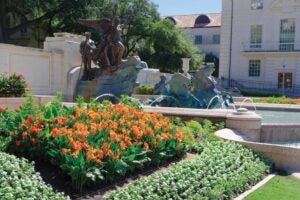AUSTIN, Texas — A new study provides public health planning authorities with a method of calculating the number of COVID-19 isolation beds they would need for people experiencing homelessness based on level of infection in the city. The research holds promise for controlling spread of the virus – or future infectious diseases – in a population that is highly vulnerable and less likely than many others to access health care services.
The report, developed to support public health decision-making in Austin, Texas, was recently published by PLOS ONE. The paper’s first author is an undergraduate student at The University of Texas at Austin, Tanvi Ingle, who harnessed her days in the pandemic lockdown to work with researchers in The University of Texas at Austin COVID-19 Modeling Consortium.
“Our model can help Austin and other cities ensure they have sufficient resources to protect populations experiencing homelessness during future disease outbreaks,” said Lauren Ancel Meyers, director of the UT Austin COVID-19 Modeling Consortium and a professor of integrative biology. “Our calculations indicated how many hotel rooms would be needed to isolate individuals when they developed symptoms or were exposed to the virus. Given that this community generally has high contact rates, poor health care and lack of privacy, these isolation facilities were critical to preventing transmission and protecting this vulnerable population.”
Projections based on the model were provided to the City of Austin during the beginning of the pandemic and helped the city finalize lease agreements for isolation facilities.

Stay-home orders are assumed to hold for either four weeks (left) or four months (right). Color indicates the reduction in non-household transmission during the intervention period, with 0% indicating no mitigation and other values indicating a combination of school closures and the specified reduction in contacts outside the home. Bed demand is the estimated number of PEH that will require isolation either while waiting for SARS-CoV-2 diagnostic test results or following a positive test result.
“The projections from the UT COVID-19 Modeling Consortium were invaluable to us in determining the potential impact and magnitude of support needed to prevent a catastrophic impact on people experiencing homelessness in Austin,” said Dr. Mark Escott, the City of Austin’s chief medical officer. “As a result, multiple area hotels were used as protective lodges to provide non-congregate sheltering to the most vulnerable members of our community.”
Before the lockdown, the undergraduate first author, Ingle, served as a clinical volunteer with Dell Medical School at the C.D. Doyle Clinic, a student-run free clinic that provides care to people experiencing homelessness. When the lockdown hit, she responded to a campus-wide call for help from the newly formed UT COVID-19 Modeling Consortium. Ingle volunteered to lead a research project that could help the homeless population navigate the challenges of the pandemic.
“From my clinical experiences, I knew that the pandemic would be especially hard for people who experience homelessness since they face unique challenges in social distancing and accessing health care. Eager to help improve the situation, I collaborated with the consortium and the City of Austin to determine how many isolation rooms we should provide to help protect our unhoused neighbors from COVID-19,” Ingle said.

Using the mathematical model of COVID-19 transmission developed by the consortium, the City of Austin could determine what proportion of people experiencing homelessness would need to be tested and how many of those individuals would test positive. With these parameters, they were then able to estimate the total number of individuals who would need an isolation room at any given time.
“This project was a way for me to see firsthand how clinical experiences inform scientific research that impacts public health outcomes,” Ingle said. “Cities around the world will be able to adapt our framework to help shape public policies in the early stages of any pandemic.”
“UT undergraduates have stepped up as researchers and leaders throughout the COVID-19 pandemic,” Meyers said. “Tanvi is an inspiring example. Her calculations helped the City of Austin to protect some of its most vulnerable populations.”
Contributors to the report in addition to Ingle and Meyers were former UT Austin undergraduate Maike Morrison (now at Stanford University); Austin’s Xutong Wang, Timothy Mercer and Spencer Fox; and Vella Karman of Austin Public Health.
This study was supported by funding from the Centers for Disease Control and Prevention and the National Institutes of Health. Tito’s Handmade Vodka provided support for the staff. The Texas Advanced Computing Center at The University of Texas at Austin provided resources that contributed to the research results.
Here is the citation in the report — This study was supported in the form of grants by Centers for Disease Control (CDC U01 IP00136) awarded to XW and LAM, and by National Institute of Health (NIH R01 AI151176) awarded to LAM. Tito’s Handmade Vodka provided support in the form of salary for SJF. The specific roles of these authors are articulated in the ‘author contributions’ section. The funders had no role in study design, data collection and analysis, decision to publish, or preparation of the manuscript.



